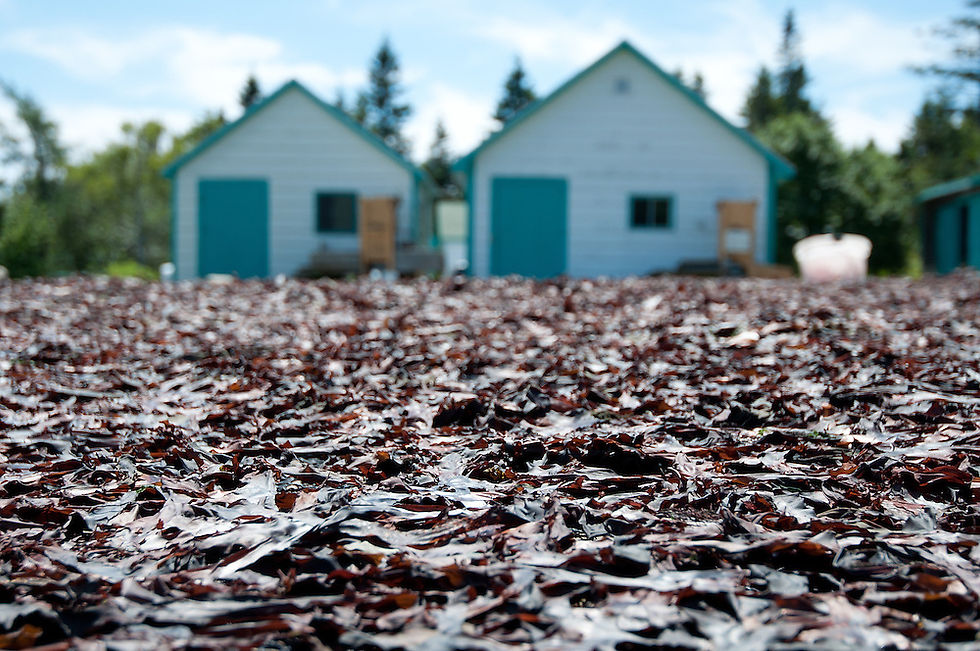Comparing Bay of Fundy Dulse and Japanese Nori
- Alec Medd
- Apr 26, 2018
- 3 min read
While Japan is most widely known for its variety of seaweed, the Bay of Fundy, known for its record breaking tides, also contains world renowned seaweed. Both Bay-of-Fundy Dulse (Palmaria palmata) and Japanese Nori (Pyropia yezoensis) belong to the red algae phylum (Rhodophyta). There are more than 7000 species of Rhodophyta, which is one of the oldest taxonomic groups of algae. Rhodophyta are more adapted for low light conditions than other green and brown algae due to their pigments that efficiently absorb light at low levels. Consequently, they flourish in temperate oceanic waters such as off of Japan and Northeastern North America.

Historically seaweed has been a tremendously important source of nutrients for groups of people living by the ocean. In the right habitat, it will grow abundantly and can be easily collected at low tide. It helps when the Bay of Fundy tides can reach 11 feet.

Seaweed has a higher concentration of iodine than any other known food source. Iodine is an important dietary nutrient because it prevents goiter development, however, excess iodine can be toxic. Fortunately, both P. yezoensis and P. palmata have concentrations low enough to be safe for consumption but high enough to provide health benefits. The Bay of Fundy Dulse is also very high in potassium and iron, while remaining surprisingly low in sodium. Meanwhile Nori contains a very wide array of vitamins and nutrients, and even in some cases has 10 times the calcium of milk.
While Nori and Bay of Fundy Dulse offer similar health benefits they are different in their appearance and how they have historically been prepared. Nori is a green seaweed that darkens when dry. Currently Nori is most frequently seen prepared in thin sheets. However, prior to the 1700s it was prepared as a paste. Nori is typically used to wrap sushi rolls but it is also frequently used to flavor soy sauce and various traditional Japanese soups. The sheets can also be toasted and added to salads to provide a crunchy texture to the salad. The taste of Nori is a combination of salty and umami.

Bay of Fundy Dulse has a similar taste to Nori being both salty and offering an umami taste. It is also crispy, however, it isn’t cut into thin slices the way that Nori is. As a result Dulse provides a different culinary experience than Nori. Dulse can be dried to be used as a stand-alone snack, or it can be ground up to be used for cooking flavoring. Sadly, Bay of Fundy Dulse has fallen out of popularity and is typically only sold within the maritimes. Global Nori consumption in contrast is becoming more widespread as sushi becomes increasingly popular in Western culture.

While I have visited the Bay of Fundy, I have never actually tried Bay of Fundy Dulse. Unfortunately, I didn’t know anything about it at the time. I have also never had Nori with exception of it being on sushi roll wraps. I don’t typically like excessively salty foods so I don’t anticipate that they will become a personal favorite, especially if they are prepared separately. However, I am considering attempting to prepare a soup containing Nori. Bay of Fundy Dulse is more difficult to acquire without traveling to the Maritimes. I hope that red algal seaweeds become a larger part of the modern Westerners diet because it is so highly nutritious and agriculturally sustainable.
Text Sources
https://www.bayoffundy.com/articles/worlds-best-dulse/
http://www.algaebase.org/browse/taxonomy/?id=97240
https://examine.com/nutrition/how-can-i-safely-consume-seaweed/
https://www.ceres.co.nz/blog/nori-the-superfood-you-should-be-eating/
https://www.bayoffundy.com/about/highest-tides/
https://www.rachaelray.com/2010/02/18/dont-call-it-seaweed-the-pleasures-of-nori/
https://www.fastcompany.com/3048813/yes-this-super-healthy-seaweed-really-does-taste-like-bacon-we-tried-it
Image Sources
https://www.precisionnutrition.com/encyclopedia/food/nori
http://cubitsorganics.com/2011/07/road-tripping-recipe-fish-chowder-in-grand-manan-new-brunswick/
https://williamdrumm.photoshelter.com/image/I0000f4fvDt7hlEI
https://en.wikipedia.org/wiki/Nori#/media/File:Nori.jpg






Comments